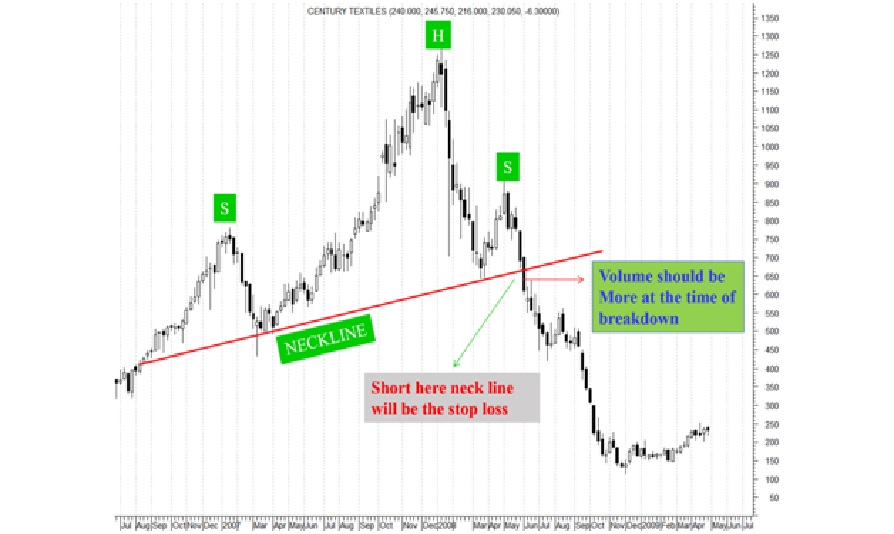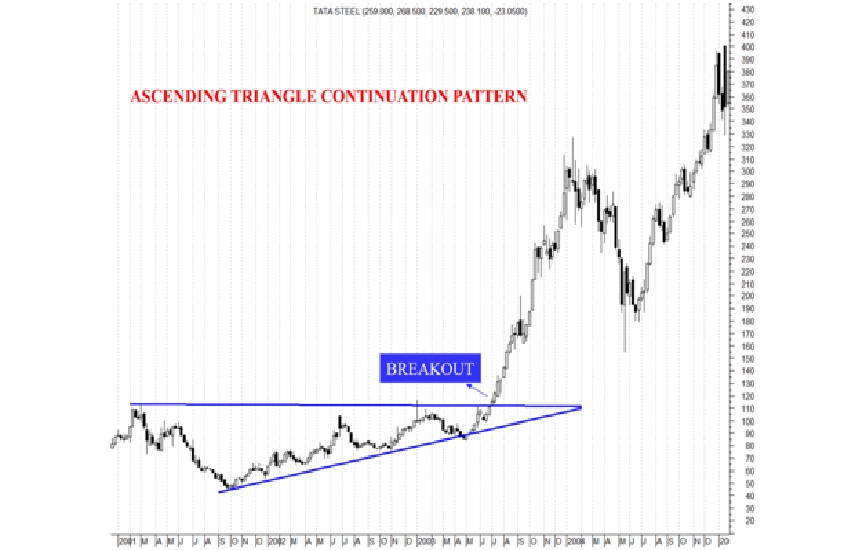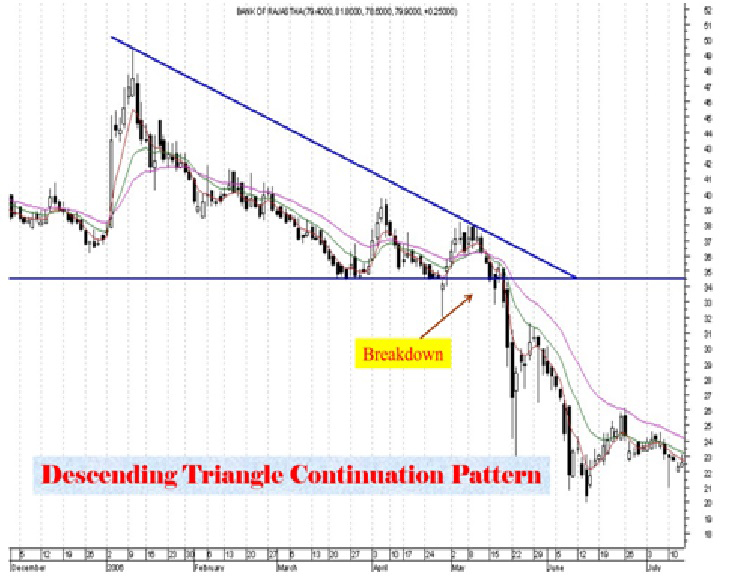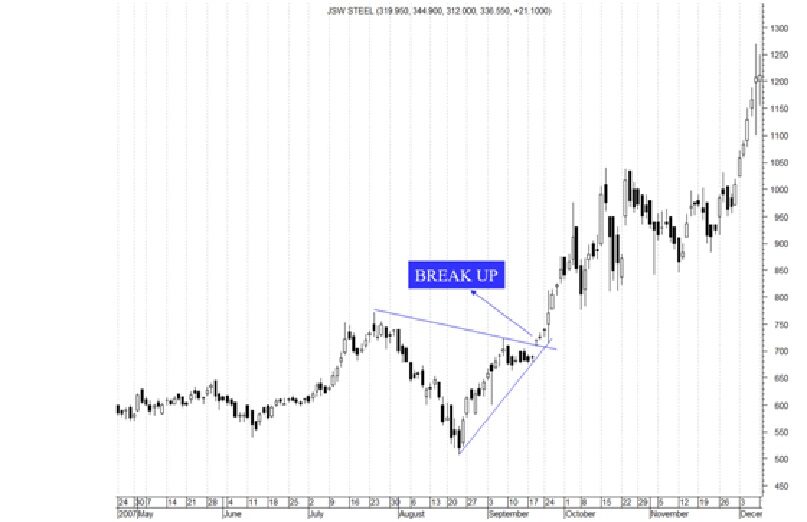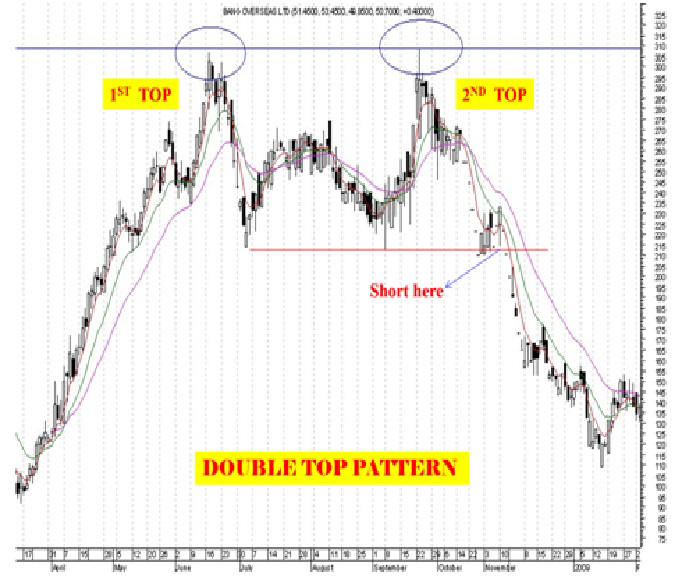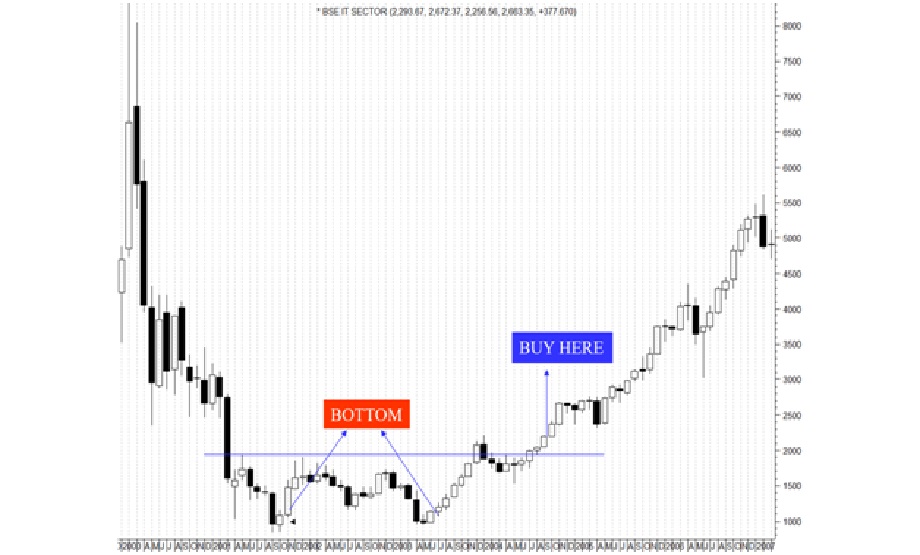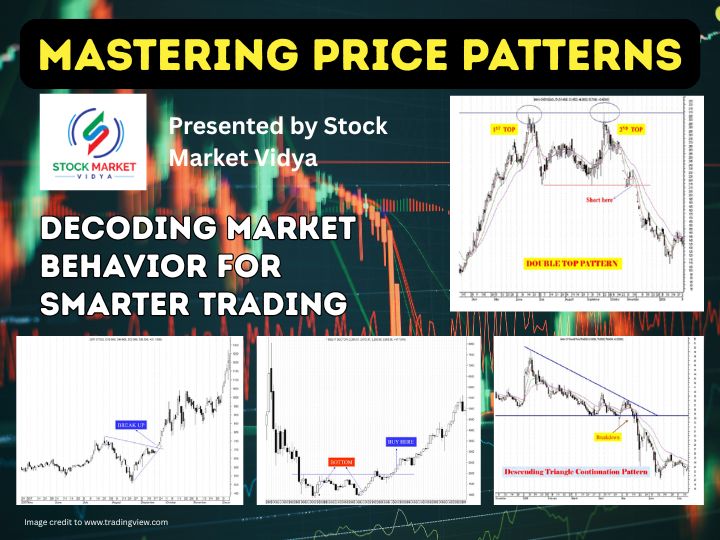Presented by Stock Market Vidya, Share Market Training Institute, Nagpur | Guided by Mr. Prashant Sarode
Introduction: The Hidden Language of Charts When you look at a stock chart, you’re not just seeing price movement — you’re witnessing a silent conversation between buyers and sellers. Every wave, every spike, every dip tells a story. This story is what traders decode using price patterns .
If you’ve ever asked, “How do successful traders predict the next move?” — the answer often lies in understanding these price formations.
Whether you’re a beginner enrolling in a stock market course or someone exploring advanced share market classes , decoding price patterns is a skill that can change the way you see the market. And at Stock Market Vidya Nagpur , you get a chance to explore these insights deeply, under the mentorship of Mr. Prashant Sarode , through some of the best share market classes in Nagpur .
What Are Price Patterns? Price patterns are recognizable shapes formed by the movement of stock prices over time. They reflect trader psychology, market sentiment, and potential direction — either continuation or reversal.
Price patterns aren’t predictions, but they are strong indications. Like traffic signals, they don’t control the market — but they often suggest what’s likely to happen next.
They help traders:
Spot potential breakout points
Understand support and resistance levels
Manage entries and exits with better timing
Whether you’re enrolled in a share market course near me stock market training .
Why Traders Swear by Price Patterns Imagine playing chess without recognizing standard strategies. You’d be lost.
Similarly, entering the market without learning price patterns is like trading blindfolded.
Here’s why mastering price patterns is crucial:
They provide structure: Markets may look chaotic, but patterns offer order.They save time: Instead of analyzing every tick, traders wait for specific patterns to appear.They help manage risk: Patterns often come with clear stop-loss and target levels.
At Stock Market Vidya , students learn how to analyze these patterns on real charts. That’s why it’s known as the best share market classes in Nagpur
Classification of Price Patterns: Continuation vs. Reversal There are two broad categories of price patterns every trader must understand:
1. Continuation Patterns These suggest that the trend will continue in the same direction.
Examples include:
Flags and Pennants : After a sharp move, price consolidates in a tight range before continuing.Triangles : Symmetrical, ascending, or descending triangles indicate a breakout is coming.Rectangles : Price bounces between two levels before breaking out in the same direction.
These patterns are particularly useful during strong market trends. When combined with stock market training
2. Reversal Patterns These indicate a potential change in the current trend.
Examples include:
Head and Shoulders : A classic reversal sign in both uptrends and downtrends.Double Top and Double Bottom : These look like “M” or “W” on charts and suggest significant turning points.Rounding Bottoms : Indicate a slow and steady change in market direction, usually bullish.
Understanding these patterns in real-time takes practice — something you experience deeply in a well-structured share market course in Nagpur .
Zooming into Popular Price Patterns Let’s break down some of the most impactful price patterns, what they mean, and how they help traders.
Head and Shoulders Image credit to www.tradingview.com This is often the first reversal pattern every trader learns.
Left Shoulder : Price rises and falls.Head : Price rises higher than the first peak and falls.Right Shoulder : Price rises again but not as high, and then falls.
This pattern indicates weakening buyer strength and a potential trend reversal. Once the “neckline” breaks, sellers often take control.
Students at Stock Market Vidya Nagpur learn to identify this pattern early, preparing them to react before the crowd.
Triangle Patterns These are visual signals that price is preparing for a move. Based on the type of triangle, you can expect:
Image credit to www.tradingview.com Ascending Triangle Typically bullish; price hits resistance multiple times while forming higher lows.
Image credit to www.tradingview.com Descending Triangle Often bearish; lower highs meet strong support.
Image credit to www.tradingview.com Symmetrical Triangle Neutral until breakout; price contracts and builds energy.
Recognizing the breakout direction with volume confirmation is a part of the expert-level stock market course
Flag and Pennant Patterns Imagine the market sprinting, taking a short breather, then continuing its run. That’s a flag or pennant in action.
Flag : Rectangular consolidation after a sharp price move.Pennant : Small symmetrical triangle after a strong surge.
These patterns are fast and profitable, perfect for traders who learn precision timing during their share market training .
Double Top & Double Bottom These are easy to identify and highly reliable.
Double Top : Two peaks at the same resistance zone = bearish sign.
Image credit to www.tradingview.com Double Bottom : Two dips at the same support = bullish sign.
Image credit to www.tradingview.com These formations reveal where the market has exhausted its current direction and is preparing to turn.
A quality stock market training program should equip you to act confidently when you see such setups.
How to Use Price Patterns in Real-World Trading Price patterns alone aren’t magic. They work best when combined with:
Volume analysis
Support and resistance zones
Timeframe confirmation
Candlestick formations
At Stock Market Vidya , we focus on pattern confirmation. Every chart tells a story, and our students learn how to interpret that story with skill and confidence.
When these concepts are taught in a share market course using real-time examples and guided chart reading, students develop practical analysis skills — not just textbook knowledge.
Mindset Matters: The Discipline Behind the Pattern Here’s the truth: most traders fail not because they don’t recognize patterns — but because they lack the patience to wait or the discipline to act.
Patterns take time to form. Markets test your emotions. That’s why our share market classes in Nagpur go beyond technical — focusing also on trader psychology, patience, and discipline.
Being able to act without emotion and execute the strategy as per the pattern is a critical part of your stock market training journey.
Combining Price Patterns with Technical Indicators While price patterns are visual, combining them with tools like:
RSI (Relative Strength Index)
MACD (Moving Average Convergence Divergence)
Moving Averages
…can enhance your accuracy.
These are covered extensively in the share market course in Nagpur offered at Stock Market Vidya. Every class takes you closer to becoming a confident chart reader.
Real Case: How a Student Used a Triangle Pattern for a Winning Trade One of our students identified a symmetrical triangle in a trending stock. After days of consolidation, the price broke out with volume. He entered at the breakout and exited with a solid 10% gain in three sessions.
This isn’t luck — it’s learning, practicing, and applying the knowledge. This is the core philosophy of our stock market course .
If you’re searching for a share market course near me , let your journey start where real strategies meet real mentorship — right here in Nagpur.
Conclusion: Price Patterns Are a Trader’s Compass Markets don’t speak with words — they speak with patterns.
Whether you’re navigating sideways markets or hunting for breakout opportunities, price patterns are your compass. They don’t predict the future with certainty, but they prepare you for what’s likely.
At Stock Market Vidya , our mission is to equip you with that preparedness — through one of the best share market classes in Nagpur Mr. Prashant Sarode , you’ll move beyond guesswork and into strategic trading.
Enroll in our stock market training
Contact Us: www.stockmarketvidya.com
FAQs on Price Patterns – Stock Market Vidya, Nagpur Q1. What are price patterns in stock market trading? Ans: Price patterns are specific shapes formed by stock price movements on a chart. These shapes, such as triangles, head and shoulders, or flags, help traders predict the potential direction of price based on past behavior. They are widely used by technical analysts and are an essential part of every quality stock market training program.
Q2. Why are price patterns important in technical analysis? Ans: Price patterns provide visual signals of market sentiment. They allow traders to understand whether a trend is likely to continue or reverse. Learning to identify these formations helps traders make informed entry and exit decisions. At Stock Market Vidya Nagpur , students learn to recognize these patterns on real charts.
Q3. Are price patterns suitable for beginners? Ans: Yes, absolutely. Beginners who are enrolled in a share market course in Nagpur share market course near me will find price patterns as one of the most practical and easy-to-understand tools in technical analysis. They form the foundation for strategic decision-making in trading.
Q4. How reliable are price patterns in predicting stock movements? Ans: While price patterns are not 100% accurate, they are highly effective when used with volume analysis and confirmation indicators. Their reliability increases when taught correctly under expert mentorship, like the guidance provided in our stock market course at Stock Market Vidya .
Q5. What is the difference between reversal and continuation patterns? Ans:
Reversal patterns signal a potential change in trend direction (e.g., Head & Shoulders, Double Top/Bottom).Continuation patterns suggest that the current trend will likely continue (e.g., Triangles, Flags, Pennants).share market classes .
Q6. Can I apply price pattern analysis to intraday trading? Ans: Yes, price patterns are widely used in intraday trading. Short-term traders look for quick formations like flags and triangles on 5-minute or 15-minute charts. Students at Stock Market Vidya Nagpur are trained to identify patterns across various timeframes for both intraday and positional trading.
Q7. Which price pattern is the most powerful for traders? Ans: Patterns like Head and Shoulders , Double Bottoms , and Symmetrical Triangles are considered powerful due to their clear structure and high probability outcomes. However, the effectiveness of a pattern depends on how well it is recognized and confirmed — something taught practically in our stock market training sessions.
Q8. How do I know when a price pattern is valid? Ans: A valid pattern typically completes with a breakout, confirmed by increased volume and movement beyond support or resistance levels. Our share market course in Nagpur emphasizes volume confirmation and teaches methods to validate patterns before taking a trade.
Q9. Do price patterns work in all markets? Ans: Yes, price patterns work across all markets — equity, commodities, forex, and even cryptocurrencies. Since patterns are based on crowd psychology, they are universal in application. The stock market training at Stock Market Vidya includes multi-market examples to help students build flexibility.
Q10. What will I learn about price patterns in Stock Market Vidya’s classes? Ans: At Stock Market Vidya , the best share market classes in Nagpur , you’ll learn:
How to identify and interpret major price patterns
Entry and exit strategies using these patterns
Real-time analysis on live charts
Risk management and confirmation tools
How to combine patterns with technical indicators for better accuracy
With expert guidance from Mr. Prashant Sarode , students gain hands-on experience that goes beyond theoretical knowledge.
Q11. Can I learn price pattern strategies online from Stock Market Vidya? Ans: Yes, Stock Market Vidya offers structured learning both online and offline. Whether you’re searching for a share market course near me or prefer virtual training, you’ll receive comprehensive education in price action and chart reading techniques.
Q12. How long does it take to master price patterns? Ans: While you can start recognizing basic patterns within weeks, mastering them with confidence takes practice. With the focused stock market training at Stock Market Vidya, many students start trading with pattern-based strategies within 2–3 months of learning.
[{"id":585,"link":"https:\/\/stockmarketvidya.com\/blogs\/gyan-box-theory-explained-simply-a-powerful-trading-concept-every-indian-trader-should-understand\/","name":"gyan-box-theory-explained-simply-a-powerful-trading-concept-every-indian-trader-should-understand","thumbnail":{"url":"https:\/\/stockmarketvidya.com\/blogs\/wp-content\/uploads\/2025\/12\/Gyan-Box-Theory-Explained-Simply.jpg","alt":"Gyan Box Theory Explained Simply"},"title":"Gyan Box Theory Explained Simply: A Powerful Trading Concept Every Indian Trader Should Understand","author":{"name":"Share Market Blog","link":"https:\/\/stockmarketvidya.com\/blogs\/author\/share-market-blog\/"},"date":"Dec 18, 2025","dateGMT":"2025-12-18 14:05:10","modifiedDate":"2025-12-18 14:10:06","modifiedDateGMT":"2025-12-18 14:10:06","commentCount":"0","commentStatus":"open","categories":{"coma":"<a href=\"https:\/\/stockmarketvidya.com\/blogs\/category\/share-market-course\/\" rel=\"category tag\">Share Market Course<\/a>, <a href=\"https:\/\/stockmarketvidya.com\/blogs\/category\/share-market\/\" rel=\"category tag\">Share Market<\/a>","space":"<a href=\"https:\/\/stockmarketvidya.com\/blogs\/category\/share-market-course\/\" rel=\"category tag\">Share Market Course<\/a> <a href=\"https:\/\/stockmarketvidya.com\/blogs\/category\/share-market\/\" rel=\"category tag\">Share Market<\/a>"},"taxonomies":{"post_tag":""},"readTime":{"min":6,"sec":55},"status":"publish","excerpt":""},{"id":582,"link":"https:\/\/stockmarketvidya.com\/blogs\/how-indian-traders-actually-use-fibonacci-in-equity-futures-options-a-practical-guide-for-todays-market\/","name":"how-indian-traders-actually-use-fibonacci-in-equity-futures-options-a-practical-guide-for-todays-market","thumbnail":{"url":"https:\/\/stockmarketvidya.com\/blogs\/wp-content\/uploads\/2025\/12\/How-Indian-Traders-Actually-Use-Fibonacci-in-Equity-Futures-Options.jpg","alt":"How Indian Traders Actually Use Fibonacci in Equity, Futures & Options"},"title":"How Indian Traders Actually Use Fibonacci in Equity, Futures & Options: A Practical Guide for Today\u2019s Market","author":{"name":"Share Market Blog","link":"https:\/\/stockmarketvidya.com\/blogs\/author\/share-market-blog\/"},"date":"Dec 16, 2025","dateGMT":"2025-12-16 07:33:30","modifiedDate":"2025-12-16 07:33:34","modifiedDateGMT":"2025-12-16 07:33:34","commentCount":"0","commentStatus":"open","categories":{"coma":"<a href=\"https:\/\/stockmarketvidya.com\/blogs\/category\/share-market\/\" rel=\"category tag\">Share Market<\/a>, <a href=\"https:\/\/stockmarketvidya.com\/blogs\/category\/share-market-course\/\" rel=\"category tag\">Share Market Course<\/a>","space":"<a href=\"https:\/\/stockmarketvidya.com\/blogs\/category\/share-market\/\" rel=\"category tag\">Share Market<\/a> <a href=\"https:\/\/stockmarketvidya.com\/blogs\/category\/share-market-course\/\" rel=\"category tag\">Share Market Course<\/a>"},"taxonomies":{"post_tag":"<a href='https:\/\/stockmarketvidya.com\/blogs\/tag\/bank-nifty-fibonacci\/' rel='post_tag'>Bank Nifty Fibonacci<\/a><a href='https:\/\/stockmarketvidya.com\/blogs\/tag\/best-share-market-classes-in-nagpur\/' rel='post_tag'>Best share market classes in Nagpur<\/a><a href='https:\/\/stockmarketvidya.com\/blogs\/tag\/equity-trading-strategy\/' rel='post_tag'>equity trading strategy<\/a><a href='https:\/\/stockmarketvidya.com\/blogs\/tag\/fibonacci-extension\/' rel='post_tag'>Fibonacci extension<\/a><a href='https:\/\/stockmarketvidya.com\/blogs\/tag\/fibonacci-in-equity-trading\/' rel='post_tag'>Fibonacci in equity trading<\/a><a href='https:\/\/stockmarketvidya.com\/blogs\/tag\/fibonacci-in-futures-trading\/' rel='post_tag'>Fibonacci in futures trading<\/a><a href='https:\/\/stockmarketvidya.com\/blogs\/tag\/fibonacci-in-options-trading\/' rel='post_tag'>Fibonacci in options trading<\/a><a href='https:\/\/stockmarketvidya.com\/blogs\/tag\/fibonacci-in-stock-market\/' rel='post_tag'>Fibonacci in stock market<\/a><a href='https:\/\/stockmarketvidya.com\/blogs\/tag\/fibonacci-retracement\/' rel='post_tag'>Fibonacci retracement<\/a><a href='https:\/\/stockmarketvidya.com\/blogs\/tag\/fibonacci-strategy-india\/' rel='post_tag'>Fibonacci strategy India<\/a><a href='https:\/\/stockmarketvidya.com\/blogs\/tag\/fibonacci-trading\/' rel='post_tag'>Fibonacci trading<\/a><a href='https:\/\/stockmarketvidya.com\/blogs\/tag\/futures-trading-strategy\/' rel='post_tag'>futures trading strategy<\/a><a href='https:\/\/stockmarketvidya.com\/blogs\/tag\/indian-stock-market-trading\/' rel='post_tag'>Indian stock market trading<\/a><a href='https:\/\/stockmarketvidya.com\/blogs\/tag\/nifty-fibonacci\/' rel='post_tag'>NIFTY Fibonacci<\/a><a href='https:\/\/stockmarketvidya.com\/blogs\/tag\/option-trading-using-fibonacci\/' rel='post_tag'>option trading using Fibonacci<\/a><a href='https:\/\/stockmarketvidya.com\/blogs\/tag\/price-action-with-fibonacci\/' rel='post_tag'>price action with Fibonacci<\/a><a href='https:\/\/stockmarketvidya.com\/blogs\/tag\/share-market-classes\/' rel='post_tag'>Share Market Classes<\/a><a href='https:\/\/stockmarketvidya.com\/blogs\/tag\/share-market-course\/' rel='post_tag'>Share Market Course<\/a><a href='https:\/\/stockmarketvidya.com\/blogs\/tag\/share-market-course-in-nagpur\/' rel='post_tag'>Share Market Course in Nagpur<\/a><a href='https:\/\/stockmarketvidya.com\/blogs\/tag\/share-market-course-near-me\/' rel='post_tag'>share market course near me<\/a><a href='https:\/\/stockmarketvidya.com\/blogs\/tag\/share-market-training\/' rel='post_tag'>Share Market Training<\/a><a href='https:\/\/stockmarketvidya.com\/blogs\/tag\/share-market-training-in-nagpur\/' rel='post_tag'>share market training in Nagpur<\/a><a href='https:\/\/stockmarketvidya.com\/blogs\/tag\/share-trading-classes-in-nagpur\/' rel='post_tag'>share trading classes in Nagpur<\/a><a href='https:\/\/stockmarketvidya.com\/blogs\/tag\/stock-market-course\/' rel='post_tag'>Stock Market Course<\/a><a href='https:\/\/stockmarketvidya.com\/blogs\/tag\/stock-market-training\/' rel='post_tag'>Stock Market Training<\/a><a href='https:\/\/stockmarketvidya.com\/blogs\/tag\/stock-market-vidya-nagpur\/' rel='post_tag'>Stock Market Vidya Nagpur<\/a><a href='https:\/\/stockmarketvidya.com\/blogs\/tag\/technical-analysis-fibonacci\/' rel='post_tag'>technical analysis Fibonacci<\/a><a href='https:\/\/stockmarketvidya.com\/blogs\/tag\/trading-strategies-india\/' rel='post_tag'>trading strategies India<\/a>"},"readTime":{"min":6,"sec":24},"status":"publish","excerpt":""},{"id":566,"link":"https:\/\/stockmarketvidya.com\/blogs\/elliott-wave-theory-explained-for-beginners-in-india-a-fresh-practical-guide-to-market-psychology-price-waves\/","name":"elliott-wave-theory-explained-for-beginners-in-india-a-fresh-practical-guide-to-market-psychology-price-waves","thumbnail":{"url":"https:\/\/stockmarketvidya.com\/blogs\/wp-content\/uploads\/2025\/12\/Elliott-Wave-Theory-Explained-for-Beginners-in-India.jpg","alt":"Elliott Wave Theory Explained for Beginners in India"},"title":"Elliott Wave Theory Explained for Beginners in India \u2013 A Fresh, Practical Guide to Market Psychology & Price Waves","author":{"name":"Share Market Blog","link":"https:\/\/stockmarketvidya.com\/blogs\/author\/share-market-blog\/"},"date":"Dec 10, 2025","dateGMT":"2025-12-10 13:15:30","modifiedDate":"2025-12-10 13:52:17","modifiedDateGMT":"2025-12-10 13:52:17","commentCount":"0","commentStatus":"open","categories":{"coma":"<a href=\"https:\/\/stockmarketvidya.com\/blogs\/category\/share-market\/\" rel=\"category tag\">Share Market<\/a>, <a href=\"https:\/\/stockmarketvidya.com\/blogs\/category\/share-market-course\/\" rel=\"category tag\">Share Market Course<\/a>","space":"<a href=\"https:\/\/stockmarketvidya.com\/blogs\/category\/share-market\/\" rel=\"category tag\">Share Market<\/a> <a href=\"https:\/\/stockmarketvidya.com\/blogs\/category\/share-market-course\/\" rel=\"category tag\">Share Market Course<\/a>"},"taxonomies":{"post_tag":"<a href='https:\/\/stockmarketvidya.com\/blogs\/tag\/bank-nifty-trading\/' rel='post_tag'>Bank Nifty trading<\/a><a href='https:\/\/stockmarketvidya.com\/blogs\/tag\/best-share-market-classes-in-nagpur\/' rel='post_tag'>Best share market classes in Nagpur<\/a><a href='https:\/\/stockmarketvidya.com\/blogs\/tag\/corrective-waves\/' rel='post_tag'>corrective waves<\/a><a href='https:\/\/stockmarketvidya.com\/blogs\/tag\/elliott-wave-for-beginners\/' rel='post_tag'>Elliott Wave for beginners<\/a><a href='https:\/\/stockmarketvidya.com\/blogs\/tag\/elliott-wave-india\/' rel='post_tag'>Elliott Wave India<\/a><a href='https:\/\/stockmarketvidya.com\/blogs\/tag\/elliott-wave-theory\/' rel='post_tag'>Elliott Wave Theory<\/a><a href='https:\/\/stockmarketvidya.com\/blogs\/tag\/fibonacci-trading\/' rel='post_tag'>Fibonacci trading<\/a><a href='https:\/\/stockmarketvidya.com\/blogs\/tag\/impulse-waves\/' rel='post_tag'>impulse waves<\/a><a href='https:\/\/stockmarketvidya.com\/blogs\/tag\/indian-stock-market-education\/' rel='post_tag'>Indian Stock Market Education<\/a><a href='https:\/\/stockmarketvidya.com\/blogs\/tag\/nifty-trading\/' rel='post_tag'>Nifty trading<\/a><a href='https:\/\/stockmarketvidya.com\/blogs\/tag\/prashant-sarode\/' rel='post_tag'>Prashant Sarode<\/a><a href='https:\/\/stockmarketvidya.com\/blogs\/tag\/share-market-classes\/' rel='post_tag'>Share Market Classes<\/a><a href='https:\/\/stockmarketvidya.com\/blogs\/tag\/share-market-course\/' rel='post_tag'>Share Market Course<\/a><a href='https:\/\/stockmarketvidya.com\/blogs\/tag\/share-market-course-in-nagpur\/' rel='post_tag'>Share Market Course in Nagpur<\/a><a href='https:\/\/stockmarketvidya.com\/blogs\/tag\/share-market-course-near-me\/' rel='post_tag'>share market course near me<\/a><a href='https:\/\/stockmarketvidya.com\/blogs\/tag\/share-market-training\/' rel='post_tag'>Share Market Training<\/a><a href='https:\/\/stockmarketvidya.com\/blogs\/tag\/share-market-training-in-nagpur\/' rel='post_tag'>share market training in Nagpur<\/a><a href='https:\/\/stockmarketvidya.com\/blogs\/tag\/share-trading-classes-in-nagpur\/' rel='post_tag'>share trading classes in Nagpur<\/a><a href='https:\/\/stockmarketvidya.com\/blogs\/tag\/stock-market-course\/' rel='post_tag'>Stock Market Course<\/a><a href='https:\/\/stockmarketvidya.com\/blogs\/tag\/stock-market-training\/' rel='post_tag'>Stock Market Training<\/a><a href='https:\/\/stockmarketvidya.com\/blogs\/tag\/stock-market-vidya-nagpur\/' rel='post_tag'>Stock Market Vidya Nagpur<\/a><a href='https:\/\/stockmarketvidya.com\/blogs\/tag\/technical-analysis-india\/' rel='post_tag'>Technical Analysis India<\/a><a href='https:\/\/stockmarketvidya.com\/blogs\/tag\/trend-analysis\/' rel='post_tag'>trend analysis<\/a><a href='https:\/\/stockmarketvidya.com\/blogs\/tag\/wave-theory-trading\/' rel='post_tag'>wave theory trading<\/a>"},"readTime":{"min":6,"sec":18},"status":"publish","excerpt":""},{"id":560,"link":"https:\/\/stockmarketvidya.com\/blogs\/stochastic-oscillator-explained-a-beginner-friendly-guide-for-indian-traders\/","name":"stochastic-oscillator-explained-a-beginner-friendly-guide-for-indian-traders","thumbnail":{"url":"https:\/\/stockmarketvidya.com\/blogs\/wp-content\/uploads\/2025\/12\/Stochastic-Oscillator-Explained.jpg","alt":"Stochastic Oscillator Lean Best share market classes in Nagpur"},"title":"Stochastic Oscillator Explained: A Beginner-Friendly Guide for Indian Traders","author":{"name":"Share Market Blog","link":"https:\/\/stockmarketvidya.com\/blogs\/author\/share-market-blog\/"},"date":"Dec 7, 2025","dateGMT":"2025-12-07 06:30:09","modifiedDate":"2025-12-07 06:57:30","modifiedDateGMT":"2025-12-07 06:57:30","commentCount":"0","commentStatus":"open","categories":{"coma":"<a href=\"https:\/\/stockmarketvidya.com\/blogs\/category\/share-market\/\" rel=\"category tag\">Share Market<\/a>, <a href=\"https:\/\/stockmarketvidya.com\/blogs\/category\/share-market-course\/\" rel=\"category tag\">Share Market Course<\/a>","space":"<a href=\"https:\/\/stockmarketvidya.com\/blogs\/category\/share-market\/\" rel=\"category tag\">Share Market<\/a> <a href=\"https:\/\/stockmarketvidya.com\/blogs\/category\/share-market-course\/\" rel=\"category tag\">Share Market Course<\/a>"},"taxonomies":{"post_tag":"<a href='https:\/\/stockmarketvidya.com\/blogs\/tag\/k-d-indicator\/' rel='post_tag'>%K %D Indicator<\/a><a href='https:\/\/stockmarketvidya.com\/blogs\/tag\/bank-nifty-trading-strategies\/' rel='post_tag'>Bank Nifty trading strategies<\/a><a href='https:\/\/stockmarketvidya.com\/blogs\/tag\/best-share-market-classes-in-nagpur\/' rel='post_tag'>Best share market classes in Nagpur<\/a><a href='https:\/\/stockmarketvidya.com\/blogs\/tag\/fast-stochastic\/' rel='post_tag'>Fast Stochastic<\/a><a href='https:\/\/stockmarketvidya.com\/blogs\/tag\/how-to-use-stochastic\/' rel='post_tag'>How to use Stochastic<\/a><a href='https:\/\/stockmarketvidya.com\/blogs\/tag\/indian-stock-market-indicators\/' rel='post_tag'>Indian stock market indicators<\/a><a href='https:\/\/stockmarketvidya.com\/blogs\/tag\/intraday-trading-indicators\/' rel='post_tag'>intraday trading indicators<\/a><a href='https:\/\/stockmarketvidya.com\/blogs\/tag\/momentum-indicators\/' rel='post_tag'>momentum indicators<\/a><a href='https:\/\/stockmarketvidya.com\/blogs\/tag\/momentum-trading-india\/' rel='post_tag'>Momentum Trading India<\/a><a href='https:\/\/stockmarketvidya.com\/blogs\/tag\/nifty-trading-strategies\/' rel='post_tag'>Nifty trading strategies<\/a><a href='https:\/\/stockmarketvidya.com\/blogs\/tag\/overbought-oversold-indicator\/' rel='post_tag'>Overbought Oversold Indicator<\/a><a href='https:\/\/stockmarketvidya.com\/blogs\/tag\/share-market-classes\/' rel='post_tag'>Share Market Classes<\/a><a href='https:\/\/stockmarketvidya.com\/blogs\/tag\/share-market-course\/' rel='post_tag'>Share Market Course<\/a><a href='https:\/\/stockmarketvidya.com\/blogs\/tag\/share-market-course-in-nagpur\/' rel='post_tag'>Share Market Course in Nagpur<\/a><a href='https:\/\/stockmarketvidya.com\/blogs\/tag\/share-market-course-near-me\/' rel='post_tag'>share market course near me<\/a><a href='https:\/\/stockmarketvidya.com\/blogs\/tag\/share-market-training\/' rel='post_tag'>Share Market Training<\/a><a href='https:\/\/stockmarketvidya.com\/blogs\/tag\/share-market-training-in-nagpur\/' rel='post_tag'>share market training in Nagpur<\/a><a href='https:\/\/stockmarketvidya.com\/blogs\/tag\/share-trading-classes-in-nagpur\/' rel='post_tag'>share trading classes in Nagpur<\/a><a href='https:\/\/stockmarketvidya.com\/blogs\/tag\/slow-stochastic\/' rel='post_tag'>Slow Stochastic<\/a><a href='https:\/\/stockmarketvidya.com\/blogs\/tag\/stochastic-indicator\/' rel='post_tag'>Stochastic Indicator<\/a><a href='https:\/\/stockmarketvidya.com\/blogs\/tag\/stochastic-oscillator\/' rel='post_tag'>Stochastic Oscillator<\/a><a href='https:\/\/stockmarketvidya.com\/blogs\/tag\/stochastic-trading-strategy\/' rel='post_tag'>Stochastic Trading Strategy<\/a><a href='https:\/\/stockmarketvidya.com\/blogs\/tag\/stock-market-course\/' rel='post_tag'>Stock Market Course<\/a><a href='https:\/\/stockmarketvidya.com\/blogs\/tag\/stock-market-training\/' rel='post_tag'>Stock Market Training<\/a><a href='https:\/\/stockmarketvidya.com\/blogs\/tag\/stock-market-vidya-nagpur\/' rel='post_tag'>Stock Market Vidya Nagpur<\/a><a href='https:\/\/stockmarketvidya.com\/blogs\/tag\/stock-trading-education-nagpur\/' rel='post_tag'>stock trading education Nagpur<\/a><a href='https:\/\/stockmarketvidya.com\/blogs\/tag\/swing-trading-indicators\/' rel='post_tag'>Swing Trading Indicators<\/a><a href='https:\/\/stockmarketvidya.com\/blogs\/tag\/technical-analysis-india\/' rel='post_tag'>Technical Analysis India<\/a><a href='https:\/\/stockmarketvidya.com\/blogs\/tag\/technical-chart-indicators\/' rel='post_tag'>Technical chart indicators<\/a><a href='https:\/\/stockmarketvidya.com\/blogs\/tag\/trading-for-beginners-india\/' rel='post_tag'>Trading for beginners India<\/a><a href='https:\/\/stockmarketvidya.com\/blogs\/tag\/trading-psychology-india\/' rel='post_tag'>Trading Psychology India<\/a>"},"readTime":{"min":7,"sec":0},"status":"publish","excerpt":""},{"id":555,"link":"https:\/\/stockmarketvidya.com\/blogs\/supertrend-strategy-for-intraday-traders-rules-signals-practical-examples\/","name":"supertrend-strategy-for-intraday-traders-rules-signals-practical-examples","thumbnail":{"url":"https:\/\/stockmarketvidya.com\/blogs\/wp-content\/uploads\/2025\/12\/Supertrend-Strategy-for-Intraday-Traders.jpg","alt":"Supertrend Strategy for Intraday Traders"},"title":"Supertrend Strategy for Intraday Traders: Rules, Signals & Practical Examples","author":{"name":"Share Market Blog","link":"https:\/\/stockmarketvidya.com\/blogs\/author\/share-market-blog\/"},"date":"Dec 4, 2025","dateGMT":"2025-12-04 09:32:33","modifiedDate":"2025-12-04 09:42:48","modifiedDateGMT":"2025-12-04 09:42:48","commentCount":"0","commentStatus":"open","categories":{"coma":"<a href=\"https:\/\/stockmarketvidya.com\/blogs\/category\/share-market\/\" rel=\"category tag\">Share Market<\/a>, <a href=\"https:\/\/stockmarketvidya.com\/blogs\/category\/share-market-course\/\" rel=\"category tag\">Share Market Course<\/a>","space":"<a href=\"https:\/\/stockmarketvidya.com\/blogs\/category\/share-market\/\" rel=\"category tag\">Share Market<\/a> <a href=\"https:\/\/stockmarketvidya.com\/blogs\/category\/share-market-course\/\" rel=\"category tag\">Share Market Course<\/a>"},"taxonomies":{"post_tag":"<a href='https:\/\/stockmarketvidya.com\/blogs\/tag\/best-share-market-classes-in-nagpur\/' rel='post_tag'>Best share market classes in Nagpur<\/a><a href='https:\/\/stockmarketvidya.com\/blogs\/tag\/intraday-trading-guide\/' rel='post_tag'>Intraday Trading Guide<\/a><a href='https:\/\/stockmarketvidya.com\/blogs\/tag\/intraday-trading-india\/' rel='post_tag'>Intraday Trading India<\/a><a href='https:\/\/stockmarketvidya.com\/blogs\/tag\/intraday-trading-strategy\/' rel='post_tag'>Intraday Trading Strategy<\/a><a href='https:\/\/stockmarketvidya.com\/blogs\/tag\/nism-certified-trainer-nagpur\/' rel='post_tag'>NISM Certified Trainer Nagpur<\/a><a href='https:\/\/stockmarketvidya.com\/blogs\/tag\/prashant-sarode-training\/' rel='post_tag'>Prashant Sarode training<\/a><a href='https:\/\/stockmarketvidya.com\/blogs\/tag\/share-market-classes\/' rel='post_tag'>Share Market Classes<\/a><a href='https:\/\/stockmarketvidya.com\/blogs\/tag\/share-market-course\/' rel='post_tag'>Share Market Course<\/a><a href='https:\/\/stockmarketvidya.com\/blogs\/tag\/share-market-course-in-nagpur\/' rel='post_tag'>Share Market Course in Nagpur<\/a><a href='https:\/\/stockmarketvidya.com\/blogs\/tag\/share-market-course-near-me\/' rel='post_tag'>share market course near me<\/a><a href='https:\/\/stockmarketvidya.com\/blogs\/tag\/share-market-training\/' rel='post_tag'>Share Market Training<\/a><a href='https:\/\/stockmarketvidya.com\/blogs\/tag\/share-market-training-in-nagpur\/' rel='post_tag'>share market training in Nagpur<\/a><a href='https:\/\/stockmarketvidya.com\/blogs\/tag\/share-trading-classes-in-nagpur\/' rel='post_tag'>share trading classes in Nagpur<\/a><a href='https:\/\/stockmarketvidya.com\/blogs\/tag\/stock-market-course\/' rel='post_tag'>Stock Market Course<\/a><a href='https:\/\/stockmarketvidya.com\/blogs\/tag\/stock-market-training\/' rel='post_tag'>Stock Market Training<\/a><a href='https:\/\/stockmarketvidya.com\/blogs\/tag\/stock-market-vidya-nagpur\/' rel='post_tag'>Stock Market Vidya Nagpur<\/a><a href='https:\/\/stockmarketvidya.com\/blogs\/tag\/supertrend-buy-signal\/' rel='post_tag'>Supertrend Buy Signal<\/a><a href='https:\/\/stockmarketvidya.com\/blogs\/tag\/supertrend-for-beginners\/' rel='post_tag'>Supertrend for Beginners<\/a><a href='https:\/\/stockmarketvidya.com\/blogs\/tag\/supertrend-indicator\/' rel='post_tag'>Supertrend Indicator<\/a><a href='https:\/\/stockmarketvidya.com\/blogs\/tag\/supertrend-sell-signal\/' rel='post_tag'>Supertrend Sell Signal<\/a><a href='https:\/\/stockmarketvidya.com\/blogs\/tag\/supertrend-settings\/' rel='post_tag'>Supertrend Settings<\/a><a href='https:\/\/stockmarketvidya.com\/blogs\/tag\/supertrend-strategy\/' rel='post_tag'>Supertrend Strategy<\/a><a href='https:\/\/stockmarketvidya.com\/blogs\/tag\/trading-indicators-india\/' rel='post_tag'>trading indicators India<\/a><a href='https:\/\/stockmarketvidya.com\/blogs\/tag\/trend-following-indicator\/' rel='post_tag'>Trend Following Indicator<\/a>"},"readTime":{"min":8,"sec":36},"status":"publish","excerpt":""},{"id":547,"link":"https:\/\/stockmarketvidya.com\/blogs\/moving-averages-in-trading-the-invisible-force-behind-trend-analysis\/","name":"moving-averages-in-trading-the-invisible-force-behind-trend-analysis","thumbnail":{"url":"https:\/\/stockmarketvidya.com\/blogs\/wp-content\/uploads\/2025\/12\/Moving-Averages-in-Trading.jpg","alt":"Learn Moving Averages in Trading Course in Nagpur"},"title":"Moving Averages in Trading: The Invisible Force Behind Trend Analysis","author":{"name":"Share Market Blog","link":"https:\/\/stockmarketvidya.com\/blogs\/author\/share-market-blog\/"},"date":"Dec 2, 2025","dateGMT":"2025-12-02 05:10:59","modifiedDate":"2025-12-02 05:36:24","modifiedDateGMT":"2025-12-02 05:36:24","commentCount":"0","commentStatus":"open","categories":{"coma":"<a href=\"https:\/\/stockmarketvidya.com\/blogs\/category\/share-market\/\" rel=\"category tag\">Share Market<\/a>, <a href=\"https:\/\/stockmarketvidya.com\/blogs\/category\/share-market-course\/\" rel=\"category tag\">Share Market Course<\/a>","space":"<a href=\"https:\/\/stockmarketvidya.com\/blogs\/category\/share-market\/\" rel=\"category tag\">Share Market<\/a> <a href=\"https:\/\/stockmarketvidya.com\/blogs\/category\/share-market-course\/\" rel=\"category tag\">Share Market Course<\/a>"},"taxonomies":{"post_tag":"<a href='https:\/\/stockmarketvidya.com\/blogs\/tag\/best-share-market-classes-in-nagpur\/' rel='post_tag'>Best share market classes in Nagpur<\/a><a href='https:\/\/stockmarketvidya.com\/blogs\/tag\/ema\/' rel='post_tag'>EMA<\/a><a href='https:\/\/stockmarketvidya.com\/blogs\/tag\/ma-crossover\/' rel='post_tag'>MA crossover<\/a><a href='https:\/\/stockmarketvidya.com\/blogs\/tag\/moving-average-strategy\/' rel='post_tag'>moving average strategy<\/a><a href='https:\/\/stockmarketvidya.com\/blogs\/tag\/moving-average-trading\/' rel='post_tag'>moving average trading<\/a><a href='https:\/\/stockmarketvidya.com\/blogs\/tag\/moving-averages\/' rel='post_tag'>moving averages<\/a><a href='https:\/\/stockmarketvidya.com\/blogs\/tag\/nism-certified-trainer\/' rel='post_tag'>NISM Certified Trainer<\/a><a href='https:\/\/stockmarketvidya.com\/blogs\/tag\/prashant-sarode\/' rel='post_tag'>Prashant Sarode<\/a><a href='https:\/\/stockmarketvidya.com\/blogs\/tag\/share-market-classes\/' rel='post_tag'>Share Market Classes<\/a><a href='https:\/\/stockmarketvidya.com\/blogs\/tag\/share-market-course\/' rel='post_tag'>Share Market Course<\/a><a href='https:\/\/stockmarketvidya.com\/blogs\/tag\/share-market-course-in-nagpur\/' rel='post_tag'>Share Market Course in Nagpur<\/a><a href='https:\/\/stockmarketvidya.com\/blogs\/tag\/share-market-course-near-me\/' rel='post_tag'>share market course near me<\/a><a href='https:\/\/stockmarketvidya.com\/blogs\/tag\/share-market-training-in-nagpur\/' rel='post_tag'>share market training in Nagpur<\/a><a href='https:\/\/stockmarketvidya.com\/blogs\/tag\/share-trading-classes-in-nagpur\/' rel='post_tag'>share trading classes in Nagpur<\/a><a href='https:\/\/stockmarketvidya.com\/blogs\/tag\/sma\/' rel='post_tag'>SMA<\/a><a href='https:\/\/stockmarketvidya.com\/blogs\/tag\/smma\/' rel='post_tag'>SMMA<\/a><a href='https:\/\/stockmarketvidya.com\/blogs\/tag\/stock-market-course\/' rel='post_tag'>Stock Market Course<\/a><a href='https:\/\/stockmarketvidya.com\/blogs\/tag\/stock-market-training\/' rel='post_tag'>Stock Market Training<\/a><a href='https:\/\/stockmarketvidya.com\/blogs\/tag\/stock-market-vidya\/' rel='post_tag'>Stock Market Vidya<\/a><a href='https:\/\/stockmarketvidya.com\/blogs\/tag\/technical-analysis\/' rel='post_tag'>Technical Analysis<\/a><a href='https:\/\/stockmarketvidya.com\/blogs\/tag\/technical-indicators\/' rel='post_tag'>Technical Indicators<\/a><a href='https:\/\/stockmarketvidya.com\/blogs\/tag\/trend-analysis\/' rel='post_tag'>trend analysis<\/a><a href='https:\/\/stockmarketvidya.com\/blogs\/tag\/trend-following\/' rel='post_tag'>trend following<\/a><a href='https:\/\/stockmarketvidya.com\/blogs\/tag\/types-of-moving-averages\/' rel='post_tag'>types of moving averages<\/a><a href='https:\/\/stockmarketvidya.com\/blogs\/tag\/wma\/' rel='post_tag'>WMA<\/a>"},"readTime":{"min":8,"sec":40},"status":"publish","excerpt":""},{"id":542,"link":"https:\/\/stockmarketvidya.com\/blogs\/bollinger-bands-mastery-the-most-flexible-indicator-for-smart-traders\/","name":"bollinger-bands-mastery-the-most-flexible-indicator-for-smart-traders","thumbnail":{"url":"https:\/\/stockmarketvidya.com\/blogs\/wp-content\/uploads\/2025\/11\/Bollinger-Bands-Mastery.jpg","alt":"Bollinger Bands Mastery"},"title":"Bollinger Bands Mastery: The Most Flexible Indicator for Smart Traders","author":{"name":"Share Market Blog","link":"https:\/\/stockmarketvidya.com\/blogs\/author\/share-market-blog\/"},"date":"Nov 27, 2025","dateGMT":"2025-11-27 09:45:50","modifiedDate":"2025-11-27 10:08:03","modifiedDateGMT":"2025-11-27 10:08:03","commentCount":"0","commentStatus":"open","categories":{"coma":"<a href=\"https:\/\/stockmarketvidya.com\/blogs\/category\/share-market\/\" rel=\"category tag\">Share Market<\/a>, <a href=\"https:\/\/stockmarketvidya.com\/blogs\/category\/share-market-course\/\" rel=\"category tag\">Share Market Course<\/a>","space":"<a href=\"https:\/\/stockmarketvidya.com\/blogs\/category\/share-market\/\" rel=\"category tag\">Share Market<\/a> <a href=\"https:\/\/stockmarketvidya.com\/blogs\/category\/share-market-course\/\" rel=\"category tag\">Share Market Course<\/a>"},"taxonomies":{"post_tag":"<a href='https:\/\/stockmarketvidya.com\/blogs\/tag\/best-share-market-classes-in-nagpur\/' rel='post_tag'>Best share market classes in Nagpur<\/a><a href='https:\/\/stockmarketvidya.com\/blogs\/tag\/bollinger-band-indicator\/' rel='post_tag'>Bollinger Band indicator<\/a><a href='https:\/\/stockmarketvidya.com\/blogs\/tag\/bollinger-bands\/' rel='post_tag'>Bollinger Bands<\/a><a href='https:\/\/stockmarketvidya.com\/blogs\/tag\/intraday-trading-indicators\/' rel='post_tag'>intraday trading indicators<\/a><a href='https:\/\/stockmarketvidya.com\/blogs\/tag\/prashant-sarode\/' rel='post_tag'>Prashant Sarode<\/a><a href='https:\/\/stockmarketvidya.com\/blogs\/tag\/price-action-trading\/' rel='post_tag'>Price Action Trading<\/a><a href='https:\/\/stockmarketvidya.com\/blogs\/tag\/share-market-classes\/' rel='post_tag'>Share Market Classes<\/a><a href='https:\/\/stockmarketvidya.com\/blogs\/tag\/share-market-course\/' rel='post_tag'>Share Market Course<\/a><a href='https:\/\/stockmarketvidya.com\/blogs\/tag\/share-market-course-in-nagpur\/' rel='post_tag'>Share Market Course in Nagpur<\/a><a href='https:\/\/stockmarketvidya.com\/blogs\/tag\/share-market-course-near-me\/' rel='post_tag'>share market course near me<\/a><a href='https:\/\/stockmarketvidya.com\/blogs\/tag\/share-market-training\/' rel='post_tag'>Share Market Training<\/a><a href='https:\/\/stockmarketvidya.com\/blogs\/tag\/share-market-training-in-nagpur\/' rel='post_tag'>share market training in Nagpur<\/a><a href='https:\/\/stockmarketvidya.com\/blogs\/tag\/share-trading-classes-in-nagpur\/' rel='post_tag'>share trading classes in Nagpur<\/a><a href='https:\/\/stockmarketvidya.com\/blogs\/tag\/stock-market-course\/' rel='post_tag'>Stock Market Course<\/a><a href='https:\/\/stockmarketvidya.com\/blogs\/tag\/stock-market-indicators\/' rel='post_tag'>stock market indicators<\/a><a href='https:\/\/stockmarketvidya.com\/blogs\/tag\/stock-market-training\/' rel='post_tag'>Stock Market Training<\/a><a href='https:\/\/stockmarketvidya.com\/blogs\/tag\/stock-market-vidya-nagpur\/' rel='post_tag'>Stock Market Vidya Nagpur<\/a><a href='https:\/\/stockmarketvidya.com\/blogs\/tag\/swing-trading-tools\/' rel='post_tag'>swing trading tools<\/a><a href='https:\/\/stockmarketvidya.com\/blogs\/tag\/technical-analysis\/' rel='post_tag'>Technical Analysis<\/a><a href='https:\/\/stockmarketvidya.com\/blogs\/tag\/trend-analysis\/' rel='post_tag'>trend analysis<\/a><a href='https:\/\/stockmarketvidya.com\/blogs\/tag\/volatility-indicator\/' rel='post_tag'>volatility indicator<\/a>"},"readTime":{"min":7,"sec":57},"status":"publish","excerpt":""},{"id":537,"link":"https:\/\/stockmarketvidya.com\/blogs\/rsi-relative-strength-index-the-most-powerful-momentum-indicator-every-trader-must-master\/","name":"rsi-relative-strength-index-the-most-powerful-momentum-indicator-every-trader-must-master","thumbnail":{"url":"https:\/\/stockmarketvidya.com\/blogs\/wp-content\/uploads\/2025\/11\/Relative-Strength-Index.jpg","alt":"Learn RSI (Relative Strength Index) in Nagpur"},"title":"RSI (Relative Strength Index): The Most Powerful Momentum Indicator Every Trader Must Master","author":{"name":"Share Market Blog","link":"https:\/\/stockmarketvidya.com\/blogs\/author\/share-market-blog\/"},"date":"Nov 24, 2025","dateGMT":"2025-11-24 07:25:16","modifiedDate":"2025-11-24 07:29:21","modifiedDateGMT":"2025-11-24 07:29:21","commentCount":"0","commentStatus":"open","categories":{"coma":"<a href=\"https:\/\/stockmarketvidya.com\/blogs\/category\/share-market\/\" rel=\"category tag\">Share Market<\/a>, <a href=\"https:\/\/stockmarketvidya.com\/blogs\/category\/share-market-course\/\" rel=\"category tag\">Share Market Course<\/a>","space":"<a href=\"https:\/\/stockmarketvidya.com\/blogs\/category\/share-market\/\" rel=\"category tag\">Share Market<\/a> <a href=\"https:\/\/stockmarketvidya.com\/blogs\/category\/share-market-course\/\" rel=\"category tag\">Share Market Course<\/a>"},"taxonomies":{"post_tag":"<a href='https:\/\/stockmarketvidya.com\/blogs\/tag\/best-share-market-classes-in-nagpur\/' rel='post_tag'>Best share market classes in Nagpur<\/a><a href='https:\/\/stockmarketvidya.com\/blogs\/tag\/chart-analysis-india\/' rel='post_tag'>chart analysis India<\/a><a href='https:\/\/stockmarketvidya.com\/blogs\/tag\/learn-technical-analysis\/' rel='post_tag'>Learn technical analysis<\/a><a href='https:\/\/stockmarketvidya.com\/blogs\/tag\/momentum-indicators\/' rel='post_tag'>momentum indicators<\/a><a href='https:\/\/stockmarketvidya.com\/blogs\/tag\/nism-certified-trainer-nagpur\/' rel='post_tag'>NISM Certified Trainer Nagpur<\/a><a href='https:\/\/stockmarketvidya.com\/blogs\/tag\/prashant-sarode-training\/' rel='post_tag'>Prashant Sarode training<\/a><a href='https:\/\/stockmarketvidya.com\/blogs\/tag\/price-action-trading\/' rel='post_tag'>Price Action Trading<\/a><a href='https:\/\/stockmarketvidya.com\/blogs\/tag\/relative-strength-index\/' rel='post_tag'>Relative Strength Index<\/a><a href='https:\/\/stockmarketvidya.com\/blogs\/tag\/rsi\/' rel='post_tag'>RSI<\/a><a href='https:\/\/stockmarketvidya.com\/blogs\/tag\/rsi-divergence\/' rel='post_tag'>RSI divergence<\/a><a href='https:\/\/stockmarketvidya.com\/blogs\/tag\/rsi-explained\/' rel='post_tag'>RSI explained<\/a><a href='https:\/\/stockmarketvidya.com\/blogs\/tag\/rsi-for-beginners\/' rel='post_tag'>RSI for beginners<\/a><a href='https:\/\/stockmarketvidya.com\/blogs\/tag\/rsi-indicator\/' rel='post_tag'>RSI indicator<\/a><a href='https:\/\/stockmarketvidya.com\/blogs\/tag\/rsi-intraday-strategy\/' rel='post_tag'>RSI intraday strategy<\/a><a href='https:\/\/stockmarketvidya.com\/blogs\/tag\/rsi-momentum-indicator\/' rel='post_tag'>RSI momentum indicator<\/a><a href='https:\/\/stockmarketvidya.com\/blogs\/tag\/rsi-swing-rejection\/' rel='post_tag'>RSI swing rejection<\/a><a href='https:\/\/stockmarketvidya.com\/blogs\/tag\/rsi-swing-trading\/' rel='post_tag'>RSI swing trading<\/a><a href='https:\/\/stockmarketvidya.com\/blogs\/tag\/rsi-trading-strategy\/' rel='post_tag'>RSI trading strategy<\/a><a href='https:\/\/stockmarketvidya.com\/blogs\/tag\/share-market-classes\/' rel='post_tag'>Share Market Classes<\/a><a href='https:\/\/stockmarketvidya.com\/blogs\/tag\/share-market-course\/' rel='post_tag'>Share Market Course<\/a><a href='https:\/\/stockmarketvidya.com\/blogs\/tag\/share-market-course-in-nagpur\/' rel='post_tag'>Share Market Course in Nagpur<\/a><a href='https:\/\/stockmarketvidya.com\/blogs\/tag\/share-market-course-near-me\/' rel='post_tag'>share market course near me<\/a><a href='https:\/\/stockmarketvidya.com\/blogs\/tag\/share-market-training\/' rel='post_tag'>Share Market Training<\/a><a href='https:\/\/stockmarketvidya.com\/blogs\/tag\/share-market-training-in-nagpur\/' rel='post_tag'>share market training in Nagpur<\/a><a href='https:\/\/stockmarketvidya.com\/blogs\/tag\/share-trading-classes-in-nagpur\/' rel='post_tag'>share trading classes in Nagpur<\/a><a href='https:\/\/stockmarketvidya.com\/blogs\/tag\/stock-market-course\/' rel='post_tag'>Stock Market Course<\/a><a href='https:\/\/stockmarketvidya.com\/blogs\/tag\/stock-market-training\/' rel='post_tag'>Stock Market Training<\/a><a href='https:\/\/stockmarketvidya.com\/blogs\/tag\/stock-market-vidya-nagpur\/' rel='post_tag'>Stock Market Vidya Nagpur<\/a><a href='https:\/\/stockmarketvidya.com\/blogs\/tag\/technical-analysis\/' rel='post_tag'>Technical Analysis<\/a><a href='https:\/\/stockmarketvidya.com\/blogs\/tag\/trading-indicators-india\/' rel='post_tag'>trading indicators India<\/a><a href='https:\/\/stockmarketvidya.com\/blogs\/tag\/trading-psychology\/' rel='post_tag'>Trading Psychology<\/a>"},"readTime":{"min":8,"sec":36},"status":"publish","excerpt":""},{"id":533,"link":"https:\/\/stockmarketvidya.com\/blogs\/macd-mastery-the-indicator-that-simplifies-market-trends-for-every-trader\/","name":"macd-mastery-the-indicator-that-simplifies-market-trends-for-every-trader","thumbnail":{"url":"https:\/\/stockmarketvidya.com\/blogs\/wp-content\/uploads\/2025\/11\/MACD-Mastery.jpg","alt":"MACD Mastery: The Indicator That Simplifies Market Trends for Every Trader"},"title":"MACD Mastery: The Indicator That Simplifies Market Trends for Every Trader","author":{"name":"Share Market Blog","link":"https:\/\/stockmarketvidya.com\/blogs\/author\/share-market-blog\/"},"date":"Nov 20, 2025","dateGMT":"2025-11-20 06:37:35","modifiedDate":"2025-11-20 06:52:23","modifiedDateGMT":"2025-11-20 06:52:23","commentCount":"0","commentStatus":"open","categories":{"coma":"<a href=\"https:\/\/stockmarketvidya.com\/blogs\/category\/share-market\/\" rel=\"category tag\">Share Market<\/a>, <a href=\"https:\/\/stockmarketvidya.com\/blogs\/category\/share-market-course\/\" rel=\"category tag\">Share Market Course<\/a>","space":"<a href=\"https:\/\/stockmarketvidya.com\/blogs\/category\/share-market\/\" rel=\"category tag\">Share Market<\/a> <a href=\"https:\/\/stockmarketvidya.com\/blogs\/category\/share-market-course\/\" rel=\"category tag\">Share Market Course<\/a>"},"taxonomies":{"post_tag":"<a href='https:\/\/stockmarketvidya.com\/blogs\/tag\/best-share-market-classes-in-nagpur\/' rel='post_tag'>Best share market classes in Nagpur<\/a><a href='https:\/\/stockmarketvidya.com\/blogs\/tag\/chart-analysis\/' rel='post_tag'>chart analysis<\/a><a href='https:\/\/stockmarketvidya.com\/blogs\/tag\/intraday-trading-tools\/' rel='post_tag'>Intraday trading tools<\/a><a href='https:\/\/stockmarketvidya.com\/blogs\/tag\/learn-technical-analysis\/' rel='post_tag'>Learn technical analysis<\/a><a href='https:\/\/stockmarketvidya.com\/blogs\/tag\/macd\/' rel='post_tag'>MACD<\/a><a href='https:\/\/stockmarketvidya.com\/blogs\/tag\/macd-indicator\/' rel='post_tag'>MACD indicator<\/a><a href='https:\/\/stockmarketvidya.com\/blogs\/tag\/macd-trading-strategy\/' rel='post_tag'>MACD trading strategy<\/a><a href='https:\/\/stockmarketvidya.com\/blogs\/tag\/momentum-trading\/' rel='post_tag'>Momentum Trading<\/a><a href='https:\/\/stockmarketvidya.com\/blogs\/tag\/moving-average-convergence-divergence\/' rel='post_tag'>Moving Average Convergence Divergence<\/a><a href='https:\/\/stockmarketvidya.com\/blogs\/tag\/prashant-sarode\/' rel='post_tag'>Prashant Sarode<\/a><a href='https:\/\/stockmarketvidya.com\/blogs\/tag\/share-market-classes\/' rel='post_tag'>Share Market Classes<\/a><a href='https:\/\/stockmarketvidya.com\/blogs\/tag\/share-market-course\/' rel='post_tag'>Share Market Course<\/a><a href='https:\/\/stockmarketvidya.com\/blogs\/tag\/share-market-course-in-nagpur\/' rel='post_tag'>Share Market Course in Nagpur<\/a><a href='https:\/\/stockmarketvidya.com\/blogs\/tag\/share-market-course-near-me\/' rel='post_tag'>share market course near me<\/a><a href='https:\/\/stockmarketvidya.com\/blogs\/tag\/share-market-training-in-nagpur\/' rel='post_tag'>share market training in Nagpur<\/a><a href='https:\/\/stockmarketvidya.com\/blogs\/tag\/share-trading-classes-in-nagpur\/' rel='post_tag'>share trading classes in Nagpur<\/a><a href='https:\/\/stockmarketvidya.com\/blogs\/tag\/stock-market-course\/' rel='post_tag'>Stock Market Course<\/a><a href='https:\/\/stockmarketvidya.com\/blogs\/tag\/stock-market-education\/' rel='post_tag'>Stock market education<\/a><a href='https:\/\/stockmarketvidya.com\/blogs\/tag\/stock-market-training\/' rel='post_tag'>Stock Market Training<\/a><a href='https:\/\/stockmarketvidya.com\/blogs\/tag\/stock-market-vidya-nagpur\/' rel='post_tag'>Stock Market Vidya Nagpur<\/a><a href='https:\/\/stockmarketvidya.com\/blogs\/tag\/swing-trading-tools\/' rel='post_tag'>swing trading tools<\/a><a href='https:\/\/stockmarketvidya.com\/blogs\/tag\/technical-analysis\/' rel='post_tag'>Technical Analysis<\/a><a href='https:\/\/stockmarketvidya.com\/blogs\/tag\/trading-indicators\/' rel='post_tag'>trading indicators<\/a><a href='https:\/\/stockmarketvidya.com\/blogs\/tag\/trend-analysis\/' rel='post_tag'>trend analysis<\/a>"},"readTime":{"min":7,"sec":32},"status":"publish","excerpt":""},{"id":526,"link":"https:\/\/stockmarketvidya.com\/blogs\/become-a-certified-trader-why-training-mentorship-matter-in-the-stock-market\/","name":"become-a-certified-trader-why-training-mentorship-matter-in-the-stock-market","thumbnail":{"url":"https:\/\/stockmarketvidya.com\/blogs\/wp-content\/uploads\/2025\/11\/Become-a-Certified-Trader-1-1.jpg","alt":"Become a Certified Trader"},"title":"Become a Certified Trader: Why Training & Mentorship Matter in the Stock Market","author":{"name":"Share Market Blog","link":"https:\/\/stockmarketvidya.com\/blogs\/author\/share-market-blog\/"},"date":"Nov 17, 2025","dateGMT":"2025-11-17 05:36:10","modifiedDate":"2025-11-17 05:45:12","modifiedDateGMT":"2025-11-17 05:45:12","commentCount":"0","commentStatus":"open","categories":{"coma":"<a href=\"https:\/\/stockmarketvidya.com\/blogs\/category\/share-market\/\" rel=\"category tag\">Share Market<\/a>","space":"<a href=\"https:\/\/stockmarketvidya.com\/blogs\/category\/share-market\/\" rel=\"category tag\">Share Market<\/a>"},"taxonomies":{"post_tag":"<a href='https:\/\/stockmarketvidya.com\/blogs\/tag\/become-a-certified-trader\/' rel='post_tag'>become a certified trader<\/a><a href='https:\/\/stockmarketvidya.com\/blogs\/tag\/best-share-market-classes-in-nagpur\/' rel='post_tag'>Best share market classes in Nagpur<\/a><a href='https:\/\/stockmarketvidya.com\/blogs\/tag\/equity-trading-course\/' rel='post_tag'>equity trading course<\/a><a href='https:\/\/stockmarketvidya.com\/blogs\/tag\/future-and-options-learning\/' rel='post_tag'>future and options learning<\/a><a href='https:\/\/stockmarketvidya.com\/blogs\/tag\/learn-share-trading\/' rel='post_tag'>learn share trading<\/a><a href='https:\/\/stockmarketvidya.com\/blogs\/tag\/learn-stock-market\/' rel='post_tag'>learn stock market<\/a><a href='https:\/\/stockmarketvidya.com\/blogs\/tag\/mr-prashant-sarode-2\/' rel='post_tag'>Mr Prashant Sarode<\/a><a href='https:\/\/stockmarketvidya.com\/blogs\/tag\/nagpur-stock-market-institute\/' rel='post_tag'>Nagpur stock market institute<\/a><a href='https:\/\/stockmarketvidya.com\/blogs\/tag\/nism-certified-trainer\/' rel='post_tag'>NISM Certified Trainer<\/a><a href='https:\/\/stockmarketvidya.com\/blogs\/tag\/options-trading-course\/' rel='post_tag'>options trading course<\/a><a href='https:\/\/stockmarketvidya.com\/blogs\/tag\/professional-trading-course\/' rel='post_tag'>professional trading course<\/a><a href='https:\/\/stockmarketvidya.com\/blogs\/tag\/share-market-classes\/' rel='post_tag'>Share Market Classes<\/a><a href='https:\/\/stockmarketvidya.com\/blogs\/tag\/share-market-course\/' rel='post_tag'>Share Market Course<\/a><a href='https:\/\/stockmarketvidya.com\/blogs\/tag\/share-market-course-in-nagpur\/' rel='post_tag'>Share Market Course in Nagpur<\/a><a href='https:\/\/stockmarketvidya.com\/blogs\/tag\/share-market-course-near-me\/' rel='post_tag'>share market course near me<\/a><a href='https:\/\/stockmarketvidya.com\/blogs\/tag\/share-market-training\/' rel='post_tag'>Share Market Training<\/a><a href='https:\/\/stockmarketvidya.com\/blogs\/tag\/share-market-training-in-nagpur\/' rel='post_tag'>share market training in Nagpur<\/a><a href='https:\/\/stockmarketvidya.com\/blogs\/tag\/share-trading-classes-in-nagpur\/' rel='post_tag'>share trading classes in Nagpur<\/a><a href='https:\/\/stockmarketvidya.com\/blogs\/tag\/stock-market-beginner-course\/' rel='post_tag'>stock market beginner course<\/a><a href='https:\/\/stockmarketvidya.com\/blogs\/tag\/stock-market-course\/' rel='post_tag'>Stock Market Course<\/a><a href='https:\/\/stockmarketvidya.com\/blogs\/tag\/stock-market-education\/' rel='post_tag'>Stock market education<\/a><a href='https:\/\/stockmarketvidya.com\/blogs\/tag\/stock-market-training\/' rel='post_tag'>Stock Market Training<\/a><a href='https:\/\/stockmarketvidya.com\/blogs\/tag\/stock-market-vidya-nagpur\/' rel='post_tag'>Stock Market Vidya Nagpur<\/a><a href='https:\/\/stockmarketvidya.com\/blogs\/tag\/technical-analysis-training\/' rel='post_tag'>Technical analysis training<\/a><a href='https:\/\/stockmarketvidya.com\/blogs\/tag\/trading-career-guidance\/' rel='post_tag'>trading career guidance<\/a><a href='https:\/\/stockmarketvidya.com\/blogs\/tag\/trading-mentorship\/' rel='post_tag'>trading mentorship<\/a><a href='https:\/\/stockmarketvidya.com\/blogs\/tag\/trading-psychology\/' rel='post_tag'>Trading Psychology<\/a><a href='https:\/\/stockmarketvidya.com\/blogs\/tag\/trading-skills-development\/' rel='post_tag'>trading skills development<\/a>"},"readTime":{"min":6,"sec":44},"status":"publish","excerpt":""},{"id":522,"link":"https:\/\/stockmarketvidya.com\/blogs\/learn-share-market-in-marathi-hindi-or-english-which-language-helps-you-become-a-smarter-trader\/","name":"learn-share-market-in-marathi-hindi-or-english-which-language-helps-you-become-a-smarter-trader","thumbnail":{"url":"https:\/\/stockmarketvidya.com\/blogs\/wp-content\/uploads\/2025\/11\/Learn-Share-Market-in-Marathi-Hindi-or-English.jpg","alt":"Hindi Marathi share market classes in Nagpur"},"title":"Learn Share Market in Marathi, Hindi or English \u2013 Which Language Helps You Become a Smarter Trader?","author":{"name":"Share Market Blog","link":"https:\/\/stockmarketvidya.com\/blogs\/author\/share-market-blog\/"},"date":"Nov 11, 2025","dateGMT":"2025-11-11 14:31:18","modifiedDate":"2025-11-11 14:31:22","modifiedDateGMT":"2025-11-11 14:31:22","commentCount":"0","commentStatus":"open","categories":{"coma":"<a href=\"https:\/\/stockmarketvidya.com\/blogs\/category\/share-market\/\" rel=\"category tag\">Share Market<\/a>, <a href=\"https:\/\/stockmarketvidya.com\/blogs\/category\/share-market-course\/\" rel=\"category tag\">Share Market Course<\/a>","space":"<a href=\"https:\/\/stockmarketvidya.com\/blogs\/category\/share-market\/\" rel=\"category tag\">Share Market<\/a> <a href=\"https:\/\/stockmarketvidya.com\/blogs\/category\/share-market-course\/\" rel=\"category tag\">Share Market Course<\/a>"},"taxonomies":{"post_tag":""},"readTime":{"min":6,"sec":49},"status":"publish","excerpt":""},{"id":516,"link":"https:\/\/stockmarketvidya.com\/blogs\/how-share-trading-classes-help-you-master-technical-analysis-and-trade-like-a-pro\/","name":"how-share-trading-classes-help-you-master-technical-analysis-and-trade-like-a-pro","thumbnail":{"url":"https:\/\/stockmarketvidya.com\/blogs\/wp-content\/uploads\/2025\/11\/How-Share-Trading-Classes-Help-You-Master-Technical-Analysis.jpg","alt":"How Share Trading Classes Help You Master Technical Analysis and Trade Like a Pro"},"title":"How Share Trading Classes Help You Master Technical Analysis and Trade Like a Pro","author":{"name":"Share Market Blog","link":"https:\/\/stockmarketvidya.com\/blogs\/author\/share-market-blog\/"},"date":"Nov 5, 2025","dateGMT":"2025-11-05 06:10:23","modifiedDate":"2025-11-05 06:11:35","modifiedDateGMT":"2025-11-05 06:11:35","commentCount":"0","commentStatus":"open","categories":{"coma":"<a href=\"https:\/\/stockmarketvidya.com\/blogs\/category\/share-market\/\" rel=\"category tag\">Share Market<\/a>, <a href=\"https:\/\/stockmarketvidya.com\/blogs\/category\/share-market-course\/\" rel=\"category tag\">Share Market Course<\/a>","space":"<a href=\"https:\/\/stockmarketvidya.com\/blogs\/category\/share-market\/\" rel=\"category tag\">Share Market<\/a> <a href=\"https:\/\/stockmarketvidya.com\/blogs\/category\/share-market-course\/\" rel=\"category tag\">Share Market Course<\/a>"},"taxonomies":{"post_tag":"<a href='https:\/\/stockmarketvidya.com\/blogs\/tag\/best-share-market-classes-in-nagpur\/' rel='post_tag'>Best share market classes in Nagpur<\/a><a href='https:\/\/stockmarketvidya.com\/blogs\/tag\/share-market-classes\/' rel='post_tag'>Share Market Classes<\/a><a href='https:\/\/stockmarketvidya.com\/blogs\/tag\/share-market-course\/' rel='post_tag'>Share Market Course<\/a><a href='https:\/\/stockmarketvidya.com\/blogs\/tag\/share-market-course-in-nagpur-2\/' rel='post_tag'>share market course in Nagpur.<\/a><a href='https:\/\/stockmarketvidya.com\/blogs\/tag\/share-market-course-near-me\/' rel='post_tag'>share market course near me<\/a><a href='https:\/\/stockmarketvidya.com\/blogs\/tag\/share-market-training\/' rel='post_tag'>Share Market Training<\/a><a href='https:\/\/stockmarketvidya.com\/blogs\/tag\/share-market-training-in-nagpur\/' rel='post_tag'>share market training in Nagpur<\/a><a href='https:\/\/stockmarketvidya.com\/blogs\/tag\/share-trading-classes-in-nagpur\/' rel='post_tag'>share trading classes in Nagpur<\/a><a href='https:\/\/stockmarketvidya.com\/blogs\/tag\/stock-market-course\/' rel='post_tag'>Stock Market Course<\/a><a href='https:\/\/stockmarketvidya.com\/blogs\/tag\/stock-market-training\/' rel='post_tag'>Stock Market Training<\/a><a href='https:\/\/stockmarketvidya.com\/blogs\/tag\/technical-analysis\/' rel='post_tag'>Technical Analysis<\/a>"},"readTime":{"min":7,"sec":9},"status":"publish","excerpt":""}]
